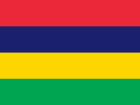
Mauritius National Plant Genetic Resources Centre

Background
The plant genetic resources conservation work started in Mauritius in 1989 under the aegis of IBPGR (IPGRI) but subsided subsequently. However, it was revived in 1997 and a Gene Bank was set up at Curepipe Experimental Station under the guidance of Dr. H. Rojoa. Preliminary work started with collection, multiplication and storage. Later, it was shifted under the Horticulture division under the responsibility of Dr. H. Rojoa. It expanded into a unit whereby two stations were created to promote the activities of the unit. It should be noted that considerable help has been obtained from SPGRC, Lusaka, Zambia of which Mauritius is a member and present Chair. Help was received in kind, training, equipment and participation at International fora.
Country
Mauritius is an island in the south west of the Indian Ocean, south of the Equator, just above the Tropic of Capricorn and lies some 850 Km to the east coast of Madagascar. It consists of a main island and a few smaller islands, which are scattered, the largest of these being Rodrigues. The total area is roughly about 1860 Km2 with a population of about 1.2 million inhabitants.
Climate
Being given the topography of the island, the land rising from sea level to a height of more than 400 meters on the central plateau. Mauritius experiences a range of microclimates from a super humid zone on the central plateau to a dry climate on the western coast ,which gives a natural diversity in the vegetation. The temperature averages 22°C in the winter months from April to September and 27°C in the summer months. The range is between 13°C on winter night on the central plateau and 33°C during the day on the western and northern parts of the island.
Vegetation
Most of the original tropical forests, which covered the island before the first settlers arrived and which was rich in indigenous flora and fauna, have been cleared to give place to sugar cane and tea fields and residential areas. Whatever indigenous flora left is to be found in the south and south western slopes of the central plateau and the south eastern part of the island around Lion Mountain. These regions have been declared Natural Reserves and are protected by Law. The endemic species occurring in these forests are under the responsibility of the Parks and Gardens Department which maintains the reserves and try to preserve their natural habitat. At the same time, it monitors closely those plants which are not thriving well due to competition from exotic species such as the privet (Ligustrum robustum) and the chinese guava (Psidium cattleianum). In this in situ protection of the indigenous plant genetic resources the Forestry Department works in close collaboration with the Division of Parks and Gardens.
Activities
Stations and Subunits of PGRU
The six hectares of cultivable land at Nouvelle Decouverte acquired in the year 2000 by the PGRU is being mainly used as a field gene bank and for regeneration and multiplication of accessions. The Endemic or Native Plants corner at Sir Seewoosagur Botanical Garden at Pamplemousses, remains under the responsibility of the PGRU.
Other Agricultural Centres under Horticulture and Agronomy Divisions are providing facilities for the implementation of the regeneration and multiplication exercises.
Technical Activities
The main activities of the PGR Unit are:
- Management of the field Gene Bank - Field Conservation of Germplasm;
- Collection of Accessions;
- Monitoring and maintenance of accessions in the Seed Gene bank.
- Regeneration , multiplication and characterisation of Accessions;
- Rescue of endangered species (e.g. Hyophorbe amaricaulis).
Management of the field Gene Bank - Field Conservation of Germplasm
There exists collection of different commodities that are planted and conserved in the field gene bank and other agricultural stations. These accessions need constant monitoring and management. The PGR field team is responsible for their maintenance.
The Table below gives a detailed summary of the existing accessions conserved on the different stations.
Agriculture
Agriculture has been one of the most important economic activities of the island until recently. But situated in a region frequently visited by cyclones which spell nothing but disaster to sugar cane plantations and crop alike, the country has been turning more and more towards other sources of revenue. However sugar cane, with its byproducts, is still the main agricultural cash crop on the island. Emphasis has been laid on diversification of the agricultural production.
Flowers, such as Anthurium, roses and orchids are now commercially grown, The production of food crops is expected to increase as from 2004 with the coming into operation of the largest reservoir in the country as more irrigation water is made available to the fertile northern plains of the island.
The island has one of the most advanced research centres in terms of sugar cane breeding and sugar technology, the Mauritius Sugar Research Institute (MSIRI). The MSIRI houses the Mauritius Herbarium, the Sugar cane Collection, and the Agronomy, Breeding and Biotechnology Lab. Here the genetic resources of the sugar cane have been used for breeding new varieties with higher sucrose content and more adaptation to the various microclimatic conditions prevailing on the island. The MSIRI has a variety of genetic materials ranging from wild sugar cane to cultivated varieties which act as a gene bank for its research purposes and is preserved in an open air museum. Work is also carried out on maize and groundnuts and some of these varieties are stored at the National Plant Genetic Resources Gene Bank.
Main Crops
|
Cash Crops:
|
sugar cane, flowers, tea , pine apple, litchi, tobacco
|
|
Cereals:
|
maize
|
|
Legumes:
|
bean, groundnut, peas, cowpea
|
|
Roots crops:
|
potato, onion, garlic, carrot, sweet potato, cassava
|
|
Fruits:
|
mango, litchi, pine apple, banana, avocado, pawpaw, star fruit, sponge fruit, jack fruit, bread fruit, some Citrus (orange, mandarine, grapefruit, lemon), melon, watermelon
|
|
Other crops:
|
Chilly, tomato, eggplant, cucurbits (pumpkin, bottle gourd, ridged gourd, snake gourd, cucumber, squash, bitter gourd), crucifers (cauliflower, cabbage, radish, mustard greens)
|
|
Number of Accessions
|
Botanical Name
|
Common Name
|
Stations
|
|
58*
|
Ipomea batatas
|
Sweet potato
|
Nouvelle Decouverte PGRC
|
|
20*
|
Ipomea batatas
|
Sweet potato
|
Curepipe E.S
|
|
4
|
Manihot esculenta
|
Cassava
|
Nouvelle Decouverte PGRC
|
|
2
|
Amorphophallus campanulatus
|
Elephant Yam
|
Nouvelle Decouverte PGRC
|
|
1
|
Canna edulis
|
Arrow Root
|
Nouvelle Decouverte PGRC
|
|
1
|
|
Corn flower
|
Nouvelle Decouverte PGRC
|
|
2
|
Colocasia sp
|
|
Congomah
|
|
8
|
Musa sp
|
Banana
|
Nouvelle Decouverte PGRC
|
|
1
|
Curcuma amada
|
Mango ginger
|
Nouvelle Decouverte PGRC
|
|
2
|
Sechium edule
|
Chow chow
|
Nouvelle Decouverte PGRC
|
|
1
|
Ananas bracteatus
|
Wild Pineapple
|
Nouvelle Decouverte PGRC
|
|
1*
|
Bactris gasipaes
|
Peach Palm
|
Nouvelle Decouverte PGRC
|
|
1
|
Bactris gasipaes
|
Peach Palm
|
Curepipe E.S
|
|
1*
|
Bactris gasipaes
|
Peach Palm
|
Richelieu ES
|
denotes accessions as duplicates
Apart from the above, litchi (Litchi chinesis), Longane Dragons Eye (Euphoria longana) and endemic forest species at SSR Botanical Garden are still being maintained by the PGR staff
Material
Collection of Accessions
New collections are being made and accessions are being added regularly as and when brought to the laboratory. The seeds are processed and given serial accession numbers - MRU followed by the number, MRU being short for Mauritius. So far we have a collection of 450 accessions which we assembled in the Gene Bank, the largest number consisting of food crop seeds mainly from the Leguminosae, Cucurbitaceae and Solanaceae families as listed above.
Characterisation
With the promotion of biotechnology in the near future, characterisation of our accessions needs to be given priority. Results from this exercise will provide our local agricultural institutions with data that may be helpful to scientists in order to allow them to make use of the valuable traits that are available in our gene bank collection. Initiation of this exercise has started in 2004. Two crops have been identified, They are okra and eggplant.
Rescue of Endangered Species in Collaboration with other Organisations

Attempt to rescue the only specimen of Hyophorbe amaricaulis found in Curepipe Botanical Garden is still ongoing. The embryo culture of Hyophorbe lagenicaulis responded positively but the plantlets died during hardening. On the other hand, one of the embryo of H. amaricaulis has initiated a shoot, thus giving a positive response. But so far no root system has been developed in the embryo culture of the latter. Dr. H. Rojoa is also presently working in collaboration with the Mauritian Wild Life Foundation Rescue Mission to attempt to rescue three endangered species of which 2-3 individuals only exist.
Documentation and Information System
The SDIS was installed in Mauritius during 2004 by SPGRC staff. Data entry has started. The missing information, which is required to complete the records, is awaited.
Organisation
National Plant Genetic Resources Committee (NPGRCom)
Mr Yacoob Mungroo - Chairperson
Mr Mustapha Kemal Nujjoo - Agricultural Superintendent Senior
Mr Mohamed Feroz Oodally - Curator
Ms Houshna Naujeer - Technical Officer
Mr Faryaz Hotee - Curator
Contacts
NPGRC Curator
Horticulture Division
University Agro-Industry & Food Security
Reduit, Mauritius
Tel: 4661734
Cell: +230 5726 2441
EMail: Mr Faryaz Hotee (Curator)


 Attempt to rescue the only specimen of Hyophorbe amaricaulis found in Curepipe Botanical Garden is still ongoing. The embryo culture of Hyophorbe lagenicaulis responded positively but the plantlets died during hardening. On the other hand, one of the embryo of H. amaricaulis has initiated a shoot, thus giving a positive response. But so far no root system has been developed in the embryo culture of the latter. Dr. H. Rojoa is also presently working in collaboration with the Mauritian Wild Life Foundation Rescue Mission to attempt to rescue three endangered species of which 2-3 individuals only exist.
Attempt to rescue the only specimen of Hyophorbe amaricaulis found in Curepipe Botanical Garden is still ongoing. The embryo culture of Hyophorbe lagenicaulis responded positively but the plantlets died during hardening. On the other hand, one of the embryo of H. amaricaulis has initiated a shoot, thus giving a positive response. But so far no root system has been developed in the embryo culture of the latter. Dr. H. Rojoa is also presently working in collaboration with the Mauritian Wild Life Foundation Rescue Mission to attempt to rescue three endangered species of which 2-3 individuals only exist.
